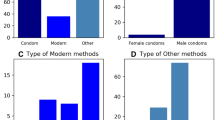Abstract
Family planning is a basic state policy in China. Its aim is to control population growth and to enhance population quality. Technical services are the key measures for implementing the family planning policy. In order to ensure that people use safe, effective, and appropriate contraceptive methods based on the government’s commitment, China has established countrywide family planning service networks down to the township level. The people can access various and convenient contraceptive services. In urban areas, all contraceptive services are free. The contraceptive prevalence rate in 2007 was 84.6%, the percentage of intrauterine device (IUD) was 52.3%, that of female sterilization was 32.3%, and that of vasectomy was 6.1%. This means that more than 90% of married childbearing couples were using long-term contraceptives. At the same time, the government gives priority to supporting research on contraceptive technology. Studies’ results have provided scientific evidence for development, introduction, and expansion of contraceptive methods, and also for establishment and revision of the technical guidelines. Great efforts have been made in promoting “human-oriented and client-centered” services during the recent ten years. Remarkable success has been achieved in improving the quality of technical services.
Similar content being viewed by others
Explore related subjects
Discover the latest articles and news from researchers in related subjects, suggested using machine learning.References
Handbook of common data in population and family planning. Beijing: China Population Publishing House, 2008, 186 (in Chinese)
National IUD Cooperation Group, Effects of 3 national IUD by a multicenter randomized clinical trial (2 year follow-up). Sheng Zhi He Bi Yun, 1987, 7(3): 39–47 (in Chinese)
Tian J, Ni F X, Wu S L, Wang Z J, Pan Q R, Sun L R, Niu Z F, Liu Z, Wu M, Sheng Y F. Study on the new intrauterine device- MCuIUD’s clinical performance, acceptability and safety. Zhong Guo Ji Hua Sheng Yu Za Zhi, 2003, 11(7): 421–423 (in Chinese)
Zhuang L Q, Yang B Y, Yuan H L. Medicated stainless steel ring-165, medicated γ-intrauterine devices and TCu220C: a multicenter comparative study. Zhong Hua Fu Chan Ke Za Zhi, 1997, 32(2): 97–101 (in Chinese)
Wu S C, Wang C P, Nan X P, Han X J, Shao W Q, Wu M H, Jing X P, Cong J, Dong J. A clinical study on reducing the bleeding side-effect of indometacin released by GyneFix-IUD. Zhong Hua Fu Chan Ke Za Zhi, 2004, 39(112): 842–843 (in Chinese)
He J L, Zheng H J, Huang Q W, Li B G, Miao W P, Liu Z C, Guo M L, Liu R, Liang Z H, Xing H, Zhong W D, Huang D X, Li A D, Huang Z Q. A randomized study on effects of YZ-2 and Hunan silver clips. Zhong Guo Ji Hua Sheng Yu Za Zhi, 1996, 4(2): 101–103 (in Chinese)
Wu C Y. Effects of female sterilization with silver clips. Zhong Hua Fu Chan Ke Za Zhi, 1994, 29(1): 53–54 (in Chinese)
Wu S C. Medical abortion in China. JAMWA, 2000, 55(3): 197–199
National IUD Cooperation Group. A study of prevention and treatment of bleeding side effects induced by IUD. Zhong Hua Fu Chan Ke Za Zhi, 1987, 22(5): 291–294 (in Chinese)
Zhang K N, Wu S C, P L, Li J J, Du R, Zhou J, Xiong Y F, Cheng Y M. Epidemiologic study on iUD use and failure in nine provinces of China. Zhong Guo Ji Hua Sheng Yu Za Zhi, 2007, 15(11): 674–677 (in Chinese)
Wu S C, Li L, Zou Y, Dong J, Lei Z W. Clinical effect comparison of seven types of iUDs placement during intermenstruum. Zhong Guo Ji Hua Sheng Yu Za Zhi, 2008, 16(9): 552–556 (in Chinese)
Gu S J, Du M K, Zhang L D, Liu Y L, Wang S H, Sivin I. A 5-year evaluation of NORPLANT contraceptive implants in China. Obstet Gynecol, 1994, 83(5 Pt 1): 673–678
Fan H M, Han L H, Jiang J W, Wu M H, Chen B Y, Meng F, Du M K, Ni F X, Zhang G Y, Tong S J, Wu S L, Wang R F, Gong X Q, Tong Y Y, Qi L F. A multicenter clinical comparative study of domestically produced implant releasing levonorgestrel No. I (CLA) and No.II(SINO) with Norplant. Sheng Zhi He Bi Yun, 2003, 23(4): 220–226 (in Chinese)
Sang G W, Weng L J, Shao Q X. Termination of pregnancy by two regimens of mifepristone and misoprostol: A multicenter clinical trial. Zhong Hua Fu Chan Ke Za Zhi, 1994, 29: 735–738 (in Chinese)
Chen L N. Termination of 10–16 weeks’ gestation with mifepristone plus misoprostol: A multicenter randomized clinical trial. Zhong Hua Fu Chan Ke Za Zhi, 1999, 5: 268–271 (in Chinese)
Xiao B L, Hertzen H, Zhao H, Piaggio G, Wu S C, Huang J, Weng L J, Zhang L J, Cheng L N, Ren F M, He C H, Gui Y L, Huang Z J, Lei Z W, Zhu M H, Song L J, Cao X M, Wang R F, Ding W H, Mei Q M, Ni F X, Zheng N. Effects of mifepristone of different doses on emergency contraception, a randomized double-blind study. Zhong Hua Yi Xue Za Zhi, 2003, 83(10): 813–818 (in Chinese)
Clinical research team for collaborative research and development on mifepristone to reduce unwanted pregnancies and recourse to abortion. Clinical study of emergency contraception with low dose mifepristone. Zhong Hua Fu Chan Ke Za Zhi, 2004, 39(1): 35–38 (in Chinese)
Author information
Authors and Affiliations
Corresponding author
Rights and permissions
About this article
Cite this article
Wu, SC. Family planning technical services in China. Front. Med. China 4, 285–289 (2010). https://doi.org/10.1007/s11684-010-0097-3
Received:
Accepted:
Published:
Issue Date:
DOI: https://doi.org/10.1007/s11684-010-0097-3



